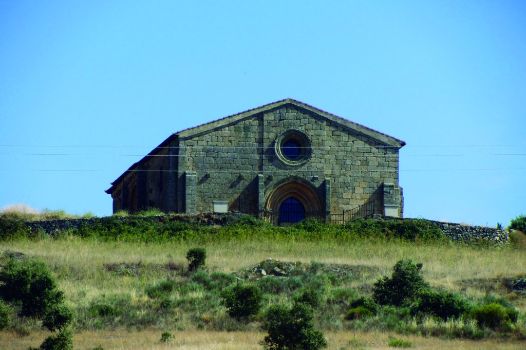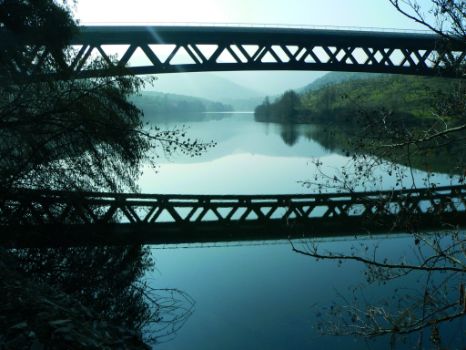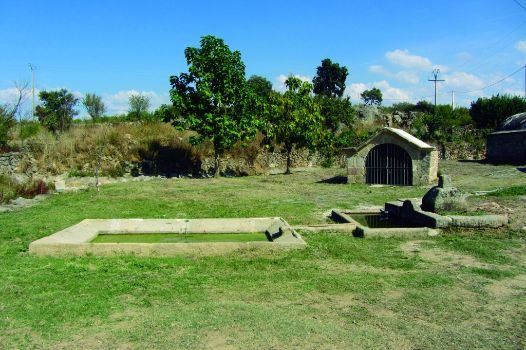Net of Natural
Trails

Stage 41: Hinojosa de Duero - Fregeneda
Description
Between walls and dehesas
The stone "casitos" of goatherds, the presence of mules or the napping cows remind us of the county’s strong farming tradition. Although the Stage is short, it still holds great beauty and peace. Some of the stretches can be challenging as they traverse through small, winding paths, wedged between stone walls, in the shade of holm oaks, ashes and cork oaks.
An information panel on this Stage stands on the southwest outskirt of Hinojosa de la Sierra. The signs lead the route to a few buildings between stone walls. If one looks back, one can see the Romanesque shrine of Cristo de la Misericordia standing on San Pedro Hill at Hinojosa de la Sierra.

The path, which is initially very wide, narrows after the fork, and becomes a small path known as La Cabrita. Sandwiched between granite walls, the path runs through places of great beauty and tranquillity, which can only be accessed on foot or bicycle with some effort. The landscape consists of rocky outcrops, holm oak (Quercus ilex) dehesas interspersed with prickly junipers (Juniperus oxycedrus) and yellow brooms (Cytisus sp.) that benefit from a decline in grazing.
The route continues mostly downwards, with a few uphill climbs that can be challenging. Further on, it reaches a crossroad with a larger path that leads to a grazing land with a watering trough and La Cabrita Fountain.
The Trail narrows again and continues between stone walls. There are a few stone "casitos" used by goatherds. The large number of holm oaks providing shade makes this journey more pleasant, especially on the short slope after the fountain.

The route begins a gentle descent towards Ribera de La Froya, where ashes (Fraxinus angustifolia) grow, and pastures are always green owing to the moist condition of the creek and the flood plain. The route passes under the metal viaduct on which the abandoned Boadilla-Fregeneda-La Barca de Alba railroad used to run. The Trail also passed under this viaduct in the previous Stage. Since railroad gradients are not steep, they are an excellent benchmark to calculate the descents.
The route crosses La Ribera de Froya Creek to the opposite bank on a wooden walkway. The Trail now runs along a narrow path flanked by a wire fence and a steep slope. Caution should be exercised, especially cyclists.
As the path begins to climb, one can look back and see the peneplain landscape of oak-ash forests and the viaduct. Soon after, the path widens and continues straight ahead, ignoring the tracks that emerge on the sides.

From kilometre 5, the route begins to descend towards the town of La Fregeneda, amidst holm and cork oaks (Quercus suber), almonds and olive trees. The vertical walls appear in the opposite side in Portugal, dominated by Penedo Durao Viewpoint. The presence of one or more mules in the farmsteads along the road is a reminder of the farming practices of the past, without machines to make work easier.
Before entering Fregeneda, the route ventures through a beautiful meadow with a restored, roofed fountain and a washhouse.
The path skirts around the north side of the village towards the impressive Roman fountain of La Fregeneda, covered by a dome and a pile of stones stacked next to it. The Stage ends here.
Sites of interest
Profile

Highlights
Further information
Grassland fauna
Grasslands retain moisture throughout the year, making it an ideal habitat for many species. This area is populated with many reptile species including snub-nosed vipers (Vipera latasti), Montpellier snakes (Malpolon monspessulanus), horseshoe whip snakes (Hemorrhois hippocrepis), Algerian sand lizard (Psammodromus algirus) and Western three-toed skink (Chalcides striatus).
Amphibians also enjoy wet areas. Natterjack toads (Bufo calamita) and spadefoot toads (Pelobates cultripes) show a preference for these places.
Mammal species, especially herbivores, thrive in this environment, including Mediterranean pine voles (Microtus duodecimcostatus), garden dormice (Eliomys quercinus), common hare (Oryctolagus cuniculus), common rabbits (Oryctolagus cuniculus) and field mice (Apodemus sylvaticus).
Animals that typically live in forests and on rocky crags can also be seen in the grasslands where they forage for food. This is particularly the case of Golden Eagles (Aquila chrysaetos), Bonelli's Eagles (Hieraaetus fasciatus), Peregrine Falcons (Falco peregrinus) and Eagle Owls (Bubo bubo).





